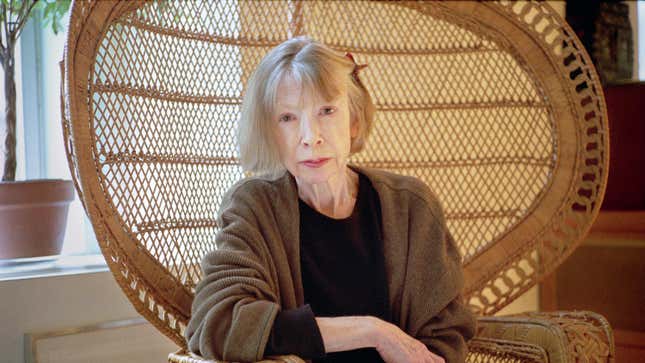Joan Didion, Icon, Is Dead at 87
She died at her home in Manhattan, of Parkinson's disease, according to her publisher, Knopf.
EntertainmentEntertainment

Joan Didion, a woman whose work shaped cultural notions of California and the 1960s, has died at 87, the New York Times reports. The official cause was Parkinson’s disease, according to an official statement from Paul Bogaards at her publisher, Knopf.
Didion’s legacy is enormous and impossible to parse. As one of the progenitors of New Journalism, her work has defined the way writing and journalism has necessarily evolved. California, her home state, was her muse, and some of Didion’s best work are her essays and fiction that interrogates what it means to be Californian. Slouching Towards Bethlehem and The White Album, two of her earliest essay collections, both consider the tail end of the ‘60s starry-eyed, drug-tinged bacchanalia of Haight-Ashbury, Hollywood, and Howard Hughes. Play It As It Lays, one of her early novels, introduces the idea of the archetypal Didion woman in Maria Wyeth, whose emotional fragility belies a steely inner strength.
Didion was born on December 5, 1934 in Sacramento, a fifth-generation Californian who can count Donner party survivors in her family tree. Didion’s early career started at Vogue, where she eventually became an associate features editor, then started writing the kind of sharply-observed and slightly pessimistic essays that would come to define her career. Didion married Gregory Dunne in 1964, and as a couple, the two embodied an idiosyncratic California cool as writers and as a unit. Didion and Dunne wrote the screenplay for Panic in Needle Park, which introduced the world to Al Pacino; more importantly, perhaps, they also rewrote the screenplay for A Star Is Born, starring Barbra Streisand and Kris Kristofferson. Though that remake of what now feels like a franchise is not the best of the bunch, it was a box-office hit.
Didion’s later work is concerned with grief; The Year of Magical Thinking is a slim elegy for her husband, Gregory, who died of a heart attack in 2003, and catalogues the depths of her grief in the wake of his death. Two years after Dunne’s death, her adopted daughter, Quintana Roo died of pancreatic cancer. Blue Nights tackles the grief of her daughter’s death. Both are useful texts for times of great sorrow, and no matter what you might think of Didion’s writing, persona, or public perception, her talent is undeniable.